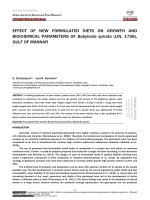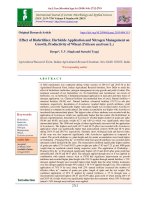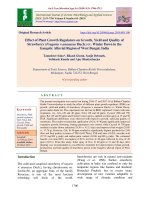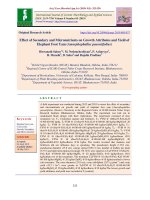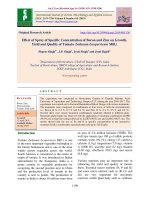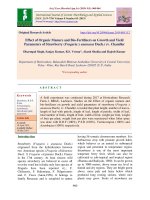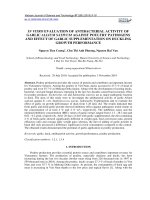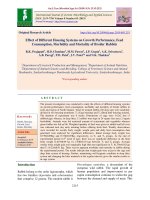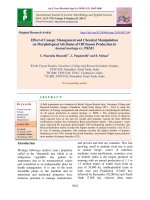Effect of secondary and micronutrients on growth attributes and yield of elephant foot yam (Amorphophallus paeoniifolius)
Bạn đang xem bản rút gọn của tài liệu. Xem và tải ngay bản đầy đủ của tài liệu tại đây (294.21 KB, 8 trang )
Int.J.Curr.Microbiol.App.Sci (2019) 8(5): 323-330
International Journal of Current Microbiology and Applied Sciences
ISSN: 2319-7706 Volume 8 Number 05 (2019)
Journal homepage:
Original Research Article
/>
Effect of Secondary and Micronutrients on Growth Attributes and Yield of
Elephant Foot Yam (Amorphophallus paeoniifolius)
Biswanath Sahoo1*, M. Nedunchezhiyan2, P. Acharyya3,
R. Munshi3, D. Sahu4 and Rojalin Pradhan5
1
Krishi Vigyan Kendra (OUAT), Ranital, Bhadrak, Odisha, India-756111
Regional Centre of ICAR-Central Tuber Crops Research Institute, Bhubaneswar,
Odisha, India-751019
3
Department of Horticulture, University of Calcutta, Kolkata, West Bengal, India- 700019
4
Department of Plant Breeding and Genetics, OUAT, Bhubaneswar, Odisha, India-751003
5
Department of Vegetable Science, OUAT, Bhubaneswar-751003, India
2
*Corresponding author
ABSTRACT
Keywords
Elephant foot yam,
Corm yield,
Growth, Secondary
and Micro nutrients
Article Info
Accepted:
04 April 2019
Available Online:
10 May 2019
A field experiment was conducted during 2012 and 2013 to assess the effect of secondary
and micronutrients on growth and yield of elephant foot yam [Amorphophallus
paeoniifolius (Dennst.) Nicolson] at the Regional Centre of ICAR-Central Tuber Crops
Research Institute, Bhubaneswar, Odisha, India. The experiment was laid out in
randomized block design with three replications. The experiment consisted of nine
treatments viz. T1- Control(no manure and fertilizer), T 2- FYM @ 10t/ha+N-P2O5-K2O
@100-60-100 kg/ha, T3-FYM @ 10 t/ha+N-P2O5-K2O @100-60-100 kg/ha+MgSO4@ 20
kg/ha, T4- FYM @ 10 t/ha+N-P2O5-K2O @100-60-100 kg/ha+ZnSO4@10 kg/ha, T5–
FYM @ 10 t/ha+N-P2O5-K2O @100-60-100 kg/ha+Borax@10 kg/ha, T 6 – FYM @ 10
t/ha+N-P2O5-K2O @100-60-100 kg/ha+MgSO4@ 20 kg/ha+ZnSO4@10 kg/ha, T7- FYM
@ 10 t/ha+N-P2O5-K2O @100-60-100 kg/ha +MgSO4@ 20 kg/ha+Borax @10 kg/ha, T8–
FYM @ 10 t/ha+N-P2O5-K2O @100-60-100 kg/ha+ZnSO4@10 kg/ha+Borax @10
kg/ha,T9- FYM @ 10 t/ha+N-P2O5-K2O @100-60-100 kg/ha+MgSO4@ 20
kg/ha+ZnSO4@10 kg/ha+Borax @10 kg/ha. The results revealed that manures and
fertilizers did not influence days to sprouting. The pseudostem height (115.8 cm),
pseudostem diameter (15.8 cm), canopy spread (109.11 cm), number of leaflets per plant
(337.5) and light interception percentage (76.74%) were superior in T 9(FYM @ 10 t/ha+NP2O5-K2O @100-60-100 kg/ha+MgSO4 @ 20 kg/ha+ZnSO4 @10 kg/ha+Borax @10
kg/ha)than rest of the treatments. The treatment T 9(FYM @ 10 t/ha+N-P2O5-K2O @10060-100 kg/ha+MgSO4 @ 20 kg/ha+ZnSO4 @10 kg/ha+Borax @10 kg/ha)resulted in lower
soil resistance. The corm diameter (25.9 cm), corm yield/plant (2375 g plant -1) and corm
yield (42.2 t ha-1) were greater in T9(FYM @ 10 t/ha+N-P2O5-K2O @100-60-100
kg/ha+MgSO4 @ 20 kg/ha+ZnSO4 @10 kg/ha+Borax @10 kg/ha).The lowest growth and
yield attributes, and yield were recorded in T 1(control).
323
Int.J.Curr.Microbiol.App.Sci (2019) 8(5): 323-330
was higher during tuber bulking stage
Kabeerathumma et al., (1987). Zinc is
regarded as the third most important limiting
nutrient element in crop production after N
and P (Gupta, 1995).It is now considered an
important yield raising input, which in
principle and practice is a part of balanced
fertilizer use. Zinc is an essential constituent
of ribosomes and is associated with the
activity of tryptophane synthates enzyme
(Chauhan et al., 2014). Boron is one of the
essential micronutrients required for the
normal growth and development of plants.
Boron is needed for the development and
differentiation of tissues particularly growing
tips, phloem and xylem (Sakal and Singh,
1995). Alfisols are mostly deficient in major
nutrients like nitrogen, phosphorus and
potassium and minor nutrients like zinc,
magnesium and boron. In our earlier study
found that FYM @ 10 t/ha+N-P2O5-K2O @
100-60-100 kg/ha was optimum for elephant
foot yam under alfisols (Sahoo et al., 2015).
Hence, the present study was carried out to
find the effects of secondary and
micronutrients along with recommended
major nutrients on elephant foot yam growth
and yield.
Introduction
Elephant
foot
yam
(Amorphophallus
paeoniifolius (Dennst.) Nicolson), a tuberous
vegetable crop is gaining importance as
commercial crop due to its unprecedented
productivity (50 t/ha) and long storability (3-5
months) (Nedunchezhiyan, 2014). The corms
(tubers) are consumed as vegetable after
boiling, baking and frying (Nedunchezhiyan
et al., 2002; Nedunchezhiyan et al., 2006).
Young leaves are also used as vegetable after
chopping and boiling (Nedunchezhiyan,
2014). Flowers are also used as food (Raghu
et al., 1999). Pickle, a delicacy recipe
preferred by Indians is also prepared from
elephant foot yam corms (Nedunchezhiyan
and Misra, 2008). The corms are rich in
minerals and vitamins (Nedunchezhiyan et
al., 2008). Elephant foot yam corm is a good
remedy for patients suffering from piles,
asthma, dysentery and abdominal pain (Misra
et al., 2002).
Elephant foot yam removes huge quantity of
nutrients. Kabeerathumma et al., (1987)
reported that a crop yielding 33 tonnes of
corms removed 128.8 kg N, 23.6 kg P, 239.6
kg K and 0.490 kg Zn per ha. Nair et al.,
(1990) observed that a crop yielding 43
tonnes of corm would remove 124.8 kg N,
25.1 kg P and 224.4 kg K per ha. Elephant
foot yam responds well to application of
manures and fertilizers. External application
of not only macro nutrients but also micro
nutrients is essential for achieving higher
yield in elephant foot yam. Magnesium (Mg),
Zinc (Zn) and Boron (B) deficiency have been
aggravated in the soil due to its continuous
removal
under
intensive
cropping.
Magnesium is a constituent of chlorophyll,
essential for photosynthesis (Chauhan et al.,
2014). It is also an activator of many enzymes
and takes part in protein synthesis. The
absorption and utilization of Mg increased
with age of the crop. However, Mg utilization
Materials and Methods
A field experiment was conducted during
2012 and 2013at the Regional Centre of
Central Tuber crops Research Institute
(20°14’53.25’’N and 85°47’25.85’’E and 33m
above mean sea level), Dumuduma,
Bhubaneswar, Odisha, India situated in the
East and South Eastern Central Coastal Plain
Zone of Odisha. The soil type of experimental
site was alfisols and falls under the family on
Typic Rhodustalfs. Texturally the soil was
sandy loam with pH6.5, organic carbon
0.32%, available nitrogen 98.2 kg/ha,
available phosphorus 16.2 kg/ha, available
potassium 242.4 kg/ha, available magnesium
1562 ppm, available zinc 1.46 ppm and
324
Int.J.Curr.Microbiol.App.Sci (2019) 8(5): 323-330
available boron 1.03 ppm. The experiment
was laid out in randomized block design
(RBD) with three replications. The
experiment consisted of nine treatments viz.
T1- Control (no manure and fertilizer), T2FYM @ 10 t/ha+N-P2O5-K2O @100-60-100
kg/ha, T3-FYM @ 10 t/ha+N-P2O5-K2O
@100-60-100 kg/ha+MgSO4 @ 20 kg/ha, T4FYM @ 10 t/ha+N-P2O5-K2O @100-60-100
kg/ha+ZnSO4 @10 kg/ha, T5– FYM @ 10
t/ha+N-P2O5-K2O @100-60-100 kg/ha+Borax
@10 kg/ha, T6 – FYM @ 10 t/ha+N-P2O5K2O @100-60-100 kg/ha+MgSO4 @ 20
kg/ha+ZnSO4 @10 kg/ha, T7- FYM @ 10
t/ha+N-P2O5-K2O
@100-60-100
kg/ha
+MgSO4 @ 20 kg/ha+Borax @10 kg/ha, T8–
FYM @ 10 t/ha+N-P2O5-K2O @100-60-100
kg/ha+ZnSO4 @10 kg/ha+Borax @10 kg/ha,
T9- FYM @ 10 t/ha+N-P2O5-K2O @100-60100 kg/ha+MgSO4 @ 20 kg/ha+ZnSO4 @10
kg/ha+Borax @10 kg/ha. Sahoo et al., (2015)
recommended FYM @ 10 t/ha+N-P2O5-K2O
@ 100-60-100 kg/ha for elephant foot yam
under alfisols.
maximum precipitation was received during
June to September.
FYM and full dose of P2O5 were applied
during final ploughing. Full dose of MgSO4,
ZnSO4 and Borax, and 1/3rd of N and K were
applied before ridge making as basal. The
remaining 2/3rd of N and K was split in to two
equal doses and applied at 1stand 2nd month
after planting (MAP). The ridges were made
at 75 cm spacing. Elephant foot yam variety
‘Gajendra’ was selected for planting. The
corm weighing 400 g was planted on the
ridges at 75 cm spacing. Thus, a spacing of
75×75cm between row-to-row and plant-toplant was maintained. Three hand weeding
was carried out at 1st, 2ndand 3rdMAP. The
crop was raised under protective drip
irrigation. The crop was harvested at 8th MAP.
During 2012 and 2013, the average mean
monthly
maximum
and
minimum
temperatures ranged 29.4-38.3°C and 15.426.6°C, respectively and mean monthly
relative humidity ranged 61.5-90.7%. The
average annual rainfall was 1254.7mm and
Results and Discussion
Growth attributes (height and diameter of
pseudostem, canopy spread and number of
leaflets per plant) were measured at 3rdand 5th
MAP. Light interception (%) at canopy was
computed at 3 and 5 MAP. Light
measurements above and below canopy were
measured with digital light meter LX-101A,
Lutron Electronic Enterprise Co., Ltd). The
difference of light measurement above and
below canopy was multiplied with 100 and
expressed in percentage of light interception.
Soil resistance was measured with
penetrologger (Eijkelkamp, The Netherlands)
at 3 and 5 MAP and expressed in MPa. Corm
yield was recorded at 8th MAP (harvest). The
data were subjected to the analysis of variance
(ANOVA) in randomized block design using
GENSTAT programme. The significant
differences between the treatments were
compared with the critical difference (CD) at
a 5% level of probability
Growth
The perusal of data (Table 1) on the days to
attainment of 50 and 100% sprouting of
elephant foot yam cv. Gajendra revealed that
manures and fertilizers had no effect on
sprouting. Application of FYM, N, P, K, Mg,
Zn and Bin various combinations resulted no
particular trend for days to 50% sprouting and
non-significant trend for days to100%
sprouting. In elephant foot yam, days to
sprouting is depend on maturity of the corm,
dormancy, type of corm (whole/cut), weight
of corm sett, soil moisture status and
prevailing weather conditions.
Elephant foot yam produces crown shaped
crop
canopy
on
the
pseudostem
(Nedunchezhiyan, 2014) and it looks like an
umbrella. During the crop growth period,
325
Int.J.Curr.Microbiol.App.Sci (2019) 8(5): 323-330
usually it produces on an average 2-3
pseudostems
(leaves)
per
plant
(Nedunchezhiyan et al., 2017). Sometime
produces multiple pseudostem when cut
corms are used due to activation of dormant
buds. At 3rd and 5th MAP, the growth
attributes were recorded on 1st and 2nd
pseudostem, respectively as suggested by
Nedunchezhiyan et al., (2016).
Light interception and soil resistance
Light interception through the canopy system
was significantly influenced by Mg, Zn and B
application in elephant foot yam (Table 2). At
3rd and 5th MAP, significantly greater light
interception was measured when the plots
were applied with FYM @ 10 t/ha+N-P2O5K2O @100-60-100 kg/ha+MgSO4 @ 20
kg/ha+ZnSO4 @10 kg/ha+Borax @10 kg/ha.
The superior light interception in this
treatment was due to greater number of
leaflets per plant (Table 1) which might have
been led to larger LAI. Higher light
interception led to higher photosynthesis and
corm yield. Sahoo et al., (2014) also reported
higher light interception in the treatment
which received greater quantity of manures
and fertilizers in elephant foot yam. The
lowest light interception was recorded in the
treatment control plots. This might be due to
poor canopy development.
Marked variation in pseudostem height and
diameter, canopy spread and number of
leaflets per plant was noticed at 3rd and 5th
MAP with respect to treatments (Table 1).
The treatment T9 (FYM @ 10 t/ha+N-P2O5K2O @100-60-100 kg/ha+MgSO4 @ 20
kg/ha+ZnSO4 @10 kg/ha+Borax @10
kg/ha)resulted in taller pseudostem, greater
pseudostem diameter, canopy spread and
number of leaves per plant at 3rdand 5thMAP.
It was followed by T8(FYM @ 10 t/ha+NP2O5-K2O @100-60-100 kg/ha+ZnSO4 @10
kg/ha+Borax @10 kg/ha). Application of Mg,
Zn and B nutrients either alone or in
combinations with recommended dose of
manures and fertilizers (FYM @ 10 t/ha+NP2O5-K2O @100-60-100 kg/ha) resulted in
greater growth attributes (pseudostem height
and diameter, canopy spread and number of
leaflets per plant) than application of
recommended dose of manures and fertilizers
alone (FYM @ 10 t/ha+N-P2O5-K2O @10060-100 kg/ha) (T2) and control (T1) (Table 1).
Soil resistance play significant role in tuber
bulking. Soil resistance recorded at 3rd and 5th
MAP revealed that lower soil resistance when
combination of Mg, Zn and B were applied
along with recommended dose of FYM @
10t/ha+N-P2O5-K2O @100-60-100 kg/ha (T9)
(Table 2). This indicated that roots were
active and occupies more volume of soil when
applied required quantity of Mg, Zn and B
nutrients along with recommended dose of
FYM @ 10t/ha+N-P2O5-K2O @100-60-100
kg/ha. Nedunchezhiyan et al., (2013) reported
that lower soil resistance in FYM and paddy
straw applied sweet potato fields. In elephant
foot yam, lower soil resistance was recorded
when greater quantity of manures and
fertilizers were applied (Sahoo et al., 2014).
Magnesium is the chief constituent of
chlorophyll which resulted in the formation of
carbohydrate in the leaves. The nutrients Zn
and B are essential for cell division and
enlargement, and various enzyme production
and activation. Application of these nutrients
increased cell division and multiplication, and
carbohydrate accumulation thereby greater
growth attributes. The results obtained were
in accordance with Kabeerathumma et al.,
(1987).
Yield
Elephant foot yam corm diameter was
profoundly influenced by treatments (Table
2). The treatment T9(FYM @ 10 t/ha+N326
Int.J.Curr.Microbiol.App.Sci (2019) 8(5): 323-330
P2O5-K2O @100-60-100 kg/ha+MgSO4 @ 20
kg/ha+ZnSO4 @10 kg/ha+Borax @10 kg/ha)
resulted in greater corm diameter. However, it
was statistically at par with T8, T7, T6, T5, T4,
T3 and T2. Significantly lower corm diameter
was noticed in control treatment. Marked
variation in corm yield per plant was observed
with respect to treatments. The treatment
T9(FYM @ 10 t/ha+N-P2O5-K2O @100-60100 kg/ha+MgSO4 @ 20 kg/ha+ZnSO4 @10
kg/ha+Borax @ 10 kg/ha) resulted in greater
corm yield/plant. However, it was statistically
at par with T8, T7, T6, T5, T4 and T3. This was
due to greater growth (Table 1) and yield
attributes (Table 2). Significantly lower corm
yield/plant was noticed in control treatment.
Discerning difference in corm yield was
observed with respect to treatments (Table 2).
The treatment T9(FYM @ 10 t/ha+N-P2O5K2O @100-60-100 kg/ha+MgSO4 @ 20
kg/ha+ZnSO4 @10 kg/ha+Borax @10 kg/ha)
resulted in greater corm yield. However, it
was statistically at par with T8, T7, T6, T5, T4
and T3. The higher corm yield in these
treatments was due to higher growth (Table 1)
and yield attributes (Table 2). The treatment
T9(FYM @ 10 t/ha+N-P2O5-K2O @100-60100 kg/ha+MgSO4 @ 20 kg/ha+ZnSO4 @10
kg/ha+Borax @10 kg/ha) produced 7.7 %
greater corm yield than T2 (FYM @ 10
t/ha+N-P2O5-K2O
@100-60-100
kg/ha)
(Table 2). Individual application of Mg, Zn
and B has increased corm yield 2.3-3.3%.
This showed that under present experimental
site, the elephant foot yam response to Mg,
Zn and B is very less. However, combined
application of all the above nutrients had the
additive effect of 7.7% greater corm yield.
The greater photosynthates accumulated in
the shoot (source) was translocated to the
bulking corm (sink). Kabeerathumma et al.,
(1987) reported that Mg utilization was higher
during tuber bulking stage, as it is essential
for carbohydrate synthesis. Singh and Pathak
(2002), and Chauhan et al., (2014) also
reported similar findings.
Table.1 Effect of Mg, Zn and B nutrients on growth attributes elephant foot yam cv. Gajendra
(pooled data of 2 years)
Trea Days to
tmen 50%
t
sprouting
28.00
T1
27.43
T2
26.81
T3
26.19
T4
25.83
T5
26.18
T6
25.04
T7
22.80
T8
28.11
T9
0.407
SE
m±
0.86
CD
(0.05
)
Days to
Pseudostem height
100%
(cm)
sprouting
3 -MAP
5 MAP
36.33
23.9
51.9
37.42
39.9
77.9
36.45
41.4
101.1
36.53
41.8
101.8
36.81
43.1
103.1
36.21
44.3
104.4
36.45
48.9
107.2
36.02
51.5
109.9
35.61
55.5
115.8
0.866
1.47
3.64
NS
3.1
7.7
Pseudostem
diameter (cm)
3 MAP 5 MAP
4.90
11.6
6.95
12.4
7.30
12.7
7.40
13.2
7.75
13.9
8.30
14.4
8.70
14.9
9.20
15.4
9.80
15.8
0.37
0.52
0.8
327
1.1
Canopy spread
Number of leaflets
(cm)
per plant
3 MAP 5 MAP 3 MAP
5 MAP
40.04
94.43
136.5
225.0
43.49
102.18
172.5
261.5
45.11
101.90
166.5
264.5
44.93
101.80
167.5
262.5
45.44
106.50
166.5
263.5
45.20
106.29
168.0
281.0
45.02
106.22
169.5
247.5
45.42
108.19
177.0
298.5
45.89
109.11
180.0
337.5
1.56
3.64
6.68
10.04
3.3
7.7
14.1
21.2
Int.J.Curr.Microbiol.App.Sci (2019) 8(5): 323-330
Table.2 Effect of Mg, Zn and B nutrients on light interception, soil resistance, yield attributes
and yield of elephant foot yam cv. Gajendra (pooled data of 2 years)
Treatment
T1
T2
T3
T4
T5
T6
T7
T8
T9
SEm ±
CD (0.05)
Light interception
(%)
3 MAP
5 MAP
22.10
48.84
24.55
51.79
20.81
64.80
53.63
58.65
46.08
61.53
47.28
63.85
54.18
67.46
57.33
67.25
61.05
76.74
1.668
1.549
3.52
3.27
Soil resistance
Corm Corm yield
(MPa)
diameter (g/plant)
(cm)
3 MAP 5 MAP
0.399
0.353
19.9
990
0.421
0.348
24.2
2210
0.416
0.368
24.0
2278
0.388
0.381
24.0
2266
0.351
0.303
24.7
2270
0.338
0.309
24.8
2338
0.331
0.264
25.4
2340
0.289
0.233
25.4
2355
0.305
0.241
25.9
2375
0.029
0.039
1.04
56.87
0.062
0.084
2.2
120
Corm
yield
(t/ha)
17.6
39.2
40.5
40.1
40.3
41.5
41.6
41.8
42.2
1.32
2.8
Table.3 Cost benefit analysis of experiment 2
Treatments
T1
T2
T3
T4
T5
T6
T7
T8
T9
SEm ±
CD (5%)
Cost of cultivation
1,57,800
1,88,720
1,90,770
1,89,870
1,90,470
1,91,970
1,92,520
1,91,920
1,93,520
8967
18920
Gross return
1,76,000
3,92,000
4,05,000
4,01,000
4,03,000
4,15,000
4,16,000
4,18,000
4,22,000
18985
40060
The treatments T9(FYM @ 10 t ha-1+N-P2O5K2O @100-60-100 kg ha-1+MgSO4 @ 20 kg
ha-1 + ZnSO4 @10 kg ha-1 + Borax @10 kg
ha-1) and T2(FYM @ 10 t ha-1+N-P2O5-K2O
@100-60-100 kg ha-1) resulted in 139.8 and
122.7% greater corm yield, respectively than
control (Table 2). The lower corm yield in
control treatment was due to less availability
of major nutrients (N, P and K), secondary
(Mg) and minor (Zn and B) nutrients to the
plants in the rhizosphere.
Net return
18,200
2,03,280
2,14,320
2,11,130
2,12,530
2,23,030
2,23,480
2,26,080
2,28,480
9540
20130
B:C ratio
1.11
2.07
2.12
2.11
2.11
2.16
2.16
2.17
2.18
0.076
0.16
In the present study, it can be concluded that
combined application of MgSO4 @ 20
kg/ha+ZnSO4 @ 10 kg/ha+Boron @10 kg/ha
along with FYM @10 t/ha+N-P2O5-K2O
@100-60-100 kg/ha was essential toget
greater corm yield under alfisols.
Economics
The perusal of Table 3 indicated that cost of
cultivation, gross return, net return and
328
Int.J.Curr.Microbiol.App.Sci (2019) 8(5): 323-330
benefit cost ratio varied with the treatment.
The cost of cultivation was found highest in
T9 followed by T7 and the lowest was
observed in T1. The variation in cost of
cultivation was due to inclusion of various
micronutrients and their combinations. The
higher gross and net returns were noticed in
T9 followed by T8. This was due to higher
yield in these treatments. Benefit cost ratio
also followed by the similar trends. The
highest being observed in T9.
(Triticum aestivum). Indian Journal of
Agronomy, 59(2): 276-80.
Gupta V K. 1995. Zinc research and
agricultural
production.
In:
Micronutrient
Research
and
Agricultural Production, Tandon, H.L.S
(Ed.). IBH & Oxford Publishing
Company, New Delhi, pp. 132-64.
Kabeerathumma S, Mohankumar B and Nair
P G. 1987. Nutrient Uptake and Their
Utilization by Yams, Aroides and
Coleus. Technical Bulletin Series
No.10,
CTCRI,
Thrivanthapuram,
Kerala, India, 34 p.
Misra
R
S,
NedunchezhiyanM,
Shivalingaswamy T M and Dison S E.
2002. Mass multiplication techniques
for producing quality planting of
Amorphophallus paeoniifolius (Dennst.)
Nicolson (Araceae). Aroideana, 25: 7887.
Nair P G, C R Mohankumar and
PSaraswathy. 1990. Effect of different
levels of NPK on the growth and yield
of Amorphophallus under upland
condition in acid ultisol. In: National
Symposium on Recent Advances in
Tropical Tuber Crops. 7-9 November,
1990, Thiruvananthapuram, Kerala.
Nedunchezhiyan M. 2014. Crop architecture
effects on elephant foot yam
(Amorphophallus
paeoniifolius)
productivity and economics under
rainfed conditions. Indian Journal of
Agronomy, 59(1): 122-7.
Nedunchezhiyan M and Misra R S. 2008.
Amorphophallus tubers invaded by
Cynodondactylon. Aroideana, 31: 12933.
Nedunchezhiyan M, Mukherjee A, Byju G,
Ravi V and George J. 2016. Growth,
dry matter production and nutrient
uptake of
elephant
foot
yam
(Amorphophallus
paeoniifolius
(Dennst.) Nicolson) as influenced by
In conclusion, the second phase of experiment
‘Effect of secondary and micro nutrients’
revealed that application of FYM @10 t ha-1 +
N-P2O5-K2O @ 100-60-100 kg ha-1 along
with MgSO4 (20 kg ha-1) + ZnSO4 (10 kg ha-1)
+ Boron (10 kg ha-1) increased the
pseudostem height, canopy spread, number of
leaflets/plant and maximum dry matter
accumulation, corm yield (42.2 t ha-1) and soil
enzyme activities. Qualitative parameters
were also found higher in the above
treatment.
Macro,
secondary
and
micronutrients helps in biofortification and
bioavailability of these nutrients in elephant
foot yam. Hence, FYM @ 10 t ha-1 + N-P2O5K2O @ 100-60-100 kg ha-1 + MgSO4 (20 kg
ha-1) + ZnSO4 (10 kg ha-1) + Boron (10 kg ha1
) can be recommended for elephant foot yam
production.
Acknowledgement
The authors are thankful to Director, Regional
Centre of Central Tuber Crops Research
Institute, Bhubaneswar for extending the
laboratory and land facility for carrying out
the research work.
References
Chauhan T M, AliJ, Singh H, Singh N and
Singh S P. 2014. Effect of Zinc and
magnesium nutrition on yield, quality
and removal of nutrients in wheat
329
Int.J.Curr.Microbiol.App.Sci (2019) 8(5): 323-330
drip irrigation and fertigation levels.
Journal of Root Crops, 42(1): 22-32.
Nedunchezhiyan M, Saurabh A and
Ranasingh N. 2006. Elephant foot yam:
A commercial crop for Orissa. Orissa
Review, 63(1): 71-2.
Nedunchezhiyan M, Sinhababu DP and
SahuP K. 2013. Effect of soil
amendments and irrigation regimes on
minimum tillage planted sweet potato
(Ipomoea batatas) in rice (Oryza sativa)
fallows under lowland conditions.
Indian Journal Agricutural Sciences,
84(3): 371–75.
Nedunchezhiyan M, Byju G and Naskar SK.
2008. Yield potential and economics of
elephant foot yam (Amorphophallus
paeoniifolius) + green gram (Vigna
radiata) intercropping system as
influenced by mulching and fertilizer
levels. Indian Journal Agricultural
Sciences, 78(1): 17-20.
Nedunchezhiyan M, Misra RS and
Shivalingaswamy TM. 2002. Elephant
foot
yam
(Amorphophallus
paeoniifolius (D.) Nicolson) as an
intercrop in banana and papaya. Orissa
Journal of Horticulture, 30(1): 80-2.
Nedunchezhiyan M, RaviV, ByjuGand
George J. 2017. Organic source of
nutrients effect on growth, yield and
quality of elephant foot yam
(Amorphophallus paeoniifolius). Indian
Journal of Agricultural Sciences, 87(8):
32-6.
Raghu A, Deepa V C and Sundaran K.1999.
A study on soorana (Amorphophallus
paeoniifolius), the king of the tubers. In:
Tropical Tuber Crops in Food Security
and Nutrition, Oxford and IBH
Publishing Co. Pvt. Ltd. New Delhi, pp.
10-4.
Sahoo BM, Nedunchezhiyan M and Acharya
P. 2014. Effects of organic and
inorganic fertilizers on yield of elephant
foot yam and soil enzymes activity.
Journal of Root Crops, 40(2): 33-9.
Sahoo BM, Nedunchezhiyan M and Acharya
P. 2015. Productivity potential of
elephant foot yam (Amorphophallus
paeoniifolius (Dennst.) Nicolson) in
alfisols as influenced by fertility levels.
The Bioscan, 10(3): 1255-7.
Sakal R and Singh AP. 1995. Boron research
and agricultural
production.
In:
Micronutrients
Research
and
Agricultural Production, Tandon, H.L.S
(Ed.). IBH & Oxford Publishing
Company, New Delhi.
Singh RN and Pathak RK. 2002. Effect of
potassium and magnesium on yield,
their uptake and quality characteristic of
wheat (Triticum aestivum). Journal of
Indian Society of Soil Science, 50: 1815.
How to cite this article:
Biswanath Sahoo, M. Nedunchezhiyan, P. Acharyya, R. Munshi, D. Sahu and Rojalin Pradhan.
2019. Effect of Secondary and Micronutrients on Growth Attributes and Yield of Elephant Foot
Yam (Amorphophallus paeoniifolius). Int.J.Curr.Microbiol.App.Sci. 8(05): 323-330.
doi: />
330
